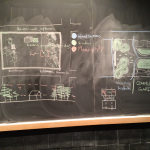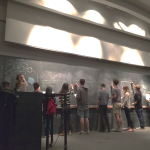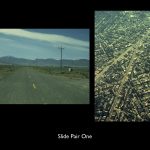With a background in education, I have a deep appreciation for the value of student-centered pedagogies; thus, my strategy in each course I teach is to employ techniques that merge general theories of learning with discipline- and course-specific goals for student outcomes. Whether I am delivering a lecture to 150 students or facilitating a small group discussion, I find ways to engage students’ mental models—their pre-existing ideas about a subject, the knowledge they obtained in an assigned reading, or their personal experiences—as a starting place for learning.
While teaching Health Promotion in a College Setting, I learned the value of an activity called “crossing the line” in which the diversity of opinions and experiences within the classroom is visually revealed as students moved back and forth across the room to signify their response to a question; students on different sides of the room are then to share their perspective with the entire class. What I appreciate most about this activity is the way in which it creates a space for students to participate in a variety of ways—from quietly selecting a side of the room to vocalizing a point of view—as well as its potential for disrupting the norms of classroom spaces: it is rare that students are invited to stand, let alone move around during class time. Inspired by the creative potential for this type of activity, I continue to employ a wide range of methods to engage students both physically and intellectually in the classroom.
In the discussion sections I facilitate for Social Factors in Architecture and Urban Design, I use a variety of methods to engage students in first understanding cultural and experiential dimensions of built environment and then applying these ideas to the evaluation and design of built environments. In our first meeting, I invite students to act out in pairs Edward T. Hall’s four proxemic zones—the “bubbles” of personal space we use to mediate social interactions—and to reflect on their previous experiences with negotiating these zones. Mid-semester, students work in small teams to propose a redesign of People’s Park in Berkeley to be more socially and ecologically sustainable, as informed by course readings on sustainability and urban parks; and each group presents their design to the rest of the class. Finally, to prepare for a semester-long ethnographic design project, I interview a student in front of the class, employing grand-tour and open-ended questions (about which students read prior to our meeting) and ask volunteers to record notes on the board; and as a group we code the notes to identify key terms. In this way we collectively engage in the techniques that will be expected of students in their ethnographic project. These examples convey my belief that learning is not only accumulative—wherein all new knowledge builds on prior knowledge—but also a social act that occurs in the context of a learning community.



In American Cultural Landscapes, I teach students from a range of majors to learn to interpret ordinary environments and use built forms as evidence in writing about cultural settings. I begin with guided reading analysis activities in which I ask students to identify the types of evidence authors employ to make arguments about a cultural landscape. In subsequent meetings, I show slides of everyday environments and invite students to read each for economic, political, and social processes; this activity helps to hone the visual skills of students and illuminate the multiplicity of possible readings of the built environment. Finally, I take students on two walking trips, first of the commercial edge of the Berkeley campus to see how storefront design has changed over time, and second to visit the New Deal buildings in Downtown Berkeley and compare their style to adjacent buildings. These methods build on each other and ultimately prepare students to analyze and write about a cultural landscape of their choice for their final paper.
In a large institution like the University of California, Berkeley I make a point of connecting with students on a one-on-one basis through formal and informal means as a way to better understand their needs and facilitate learning and engagement. I use time before class begins to ask students about the classes they are taking; this strategy is especially helpful to learn when students have major reviews in studio or a major exam elsewhere and thus may need additional support in my own course. I use office hours as a way to understand individual interests and experiences in the course and to follow up with quieter students in class; I also share articles I come across that are relevant to student interests and paper topics as a way to initiate one-on-one discussion.
To learn more about the efficacy of these teaching practices, see Impact.